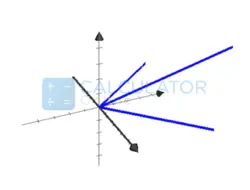Adblocker Detected

We always struggled to serve you with the best online calculations, thus, there's a humble request to either disable the AD blocker or go with premium plans to use the AD-Free version for calculators.
Disable your Adblocker and refresh your web page 😊
Table of Content
The free online Gram Schmidt calculator finds the Orthonormalized set of vectors by Orthonormal basis of independence vectors. The process looks overwhelmingly difficult to understand at first sight, but you can understand it by finding the Orthonormal basis of the independent vector by the Gram-Schmidt calculator.
The Gram-Schmidt process (or procedure) is a sequence of operations that enables us to transform a set of linearly independent vectors into a related set of orthogonal vectors that span around the same plan. It can be convenient for us to implement the Gram-Schmidt process by the gram Schmidt calculator.
The Gram-Schmidt orthogonalization is also known as the Gram-Schmidt process. In which we take the non-orthogonal set of vectors and construct the orthogonal basis of vectors and find their orthonormal vectors. The orthogonal basis calculator is a simple way to find the orthonormal vectors of free, independent vectors in three dimensional space.
The Gram-Schmidt process (or procedure) is a chain of operation that allows us to transform a set of linear independent vectors into a set of orthonormal vectors that span around the same space of the original vectors. The Gram Schmidt calculator turns the independent set of vectors into the Orthonormal basis in the blink of an eye.
The Orthonormal vectors are the same as the normal or the perpendicular vectors in two dimensions or x and y plane. When we are going to find the vectors in the three dimensional plan, then these vectors are called the orthonormal vectors. We need a special orthonormal basis calculator to find the orthonormal vectors.
Consider a set of vectors:
The original vectors are V1,V2, V3,…Vn. The orthonormal basis vectors are U1,U2,U3,…,Un
So we have:
Original vectors → orthonormal basis vectors
V1,V2, V3,…Vn→ U1,U2,U3,…,Un
The original independent Vectors

The Orthonormal basis Vectors
.webp)
To find the Orthonormal basis vector, follow the steps given as under:
We can Perform the gram schmidt process on the following sequence of vectors:
U1=V1
U2= V2- {(V2,U1)/(|U|1)^2}*U1
U3= V3- {(V3,U1)/(|U1|)^2}*U1- {(V3,U2)/(|U2|)^2}*U2
Now U1,U2,U3,…,Un are the orthonormal basis vectors of the original vectors V1,V2, V3,…Vn
Now for Un, we can write:
$$ \vec{u_k} =\vec{v_k} -\sum_{j=1}^{k-1}{\frac{\vec{u_j} .\vec{v_k} }{\vec{u_j}.\vec{u_j} } \vec{u_j} }\ ,\quad \vec{e_k} =\frac{\vec{u_k} }{\|\vec{u_k}\|}$$
You can write the above expression as follows, We can find the orthogonal basis vectors of the original vector by the gram schmidt calculator.
Consider the following two vector, we perform the gram schmidt process on the following sequence of vectors
$$V_1=\begin{bmatrix}2\\6\\\end{bmatrix}\,V_1 =\begin{bmatrix}4\\8\\\end{bmatrix}$$
By the simple formula we can measure the projection of the vectors
$$ \ \vec{u_k} = \vec{v_k} – \Sigma_{j-1}^\text{k-1} \ proj_\vec{u_j} \ (\vec{v_k}) \ \text{where} \ proj_\vec{uj} \ (\vec{v_k}) = \frac{ \vec{u_j} \cdot \vec{v_k}}{|{\vec{u_j}}|^2} \vec{u_j} \} $$
Step 1:
$$ \vec{u_1} = \vec{v_1} = \begin{bmatrix} 2 \\6 \end{bmatrix} $$
It is simple to calculate the unit vector by the unit vector calculator, and it can be convenient for us.
$$ \vec{u_1} \ = \ \vec{v_1} \ = \ \begin{bmatrix} 0.32 \\ 0.95 \end{bmatrix} $$
Step 2:
The vector projection calculator can make the whole step of finding the projection just too simple for you.
$$ proj_\vec{u_1} \ (\vec{v_2}) \ = \ \begin{bmatrix} 2.8 \\ 8.4 \end{bmatrix} $$
The Subtraction of the vectors is :
$$ \vec{u_2} \ = \ \vec{v_2} \ – \ proj_\vec{u_1} \ (\vec{v_2}) \ = \ \begin{bmatrix} 1.2 \\ -0.4 \end{bmatrix} $$
Step 3
The Final Orthonormal vector is:
$$ \vec{e_2} \ = \ \frac{\vec{u_2}}{| \vec{u_2 }|} \ = \ \begin{bmatrix} 0.95 \\ -0.32 \end{bmatrix} $$
Let’s use the Gram Schmidt Process Calculator to find perpendicular or orthonormal vectors in a three dimensional plan.
Input:
Output:
The Gram Schmidt Calculator readily finds the orthonormal set of vectors of the linear independent vectors.
A vector needs the magnitude and the direction to represent.
The difference between the orthogonal and the orthonormal vectors do involve both the vectors {u,v}, which involve the original vectors and its orthogonal basis vectors. The orthonormal vectors we only define are a series of the orthonormal vectors {u,u} vectors. Where {u,v}=0, and {u,u}=1, The linear vectors orthonormal vectors can be measured by the linear algebra calculator.
A square matrix with a real number is an orthogonalized matrix, if its transpose is equal to the inverse of the matrix. The orthogonal matrix calculator is an especially designed calculator to find the Orthogonalized matrix.
The (a1.b1) + (a2. b2) + (a3. b3) …. + (an.bn) can be used to find the dot product for any number of vectors.
The two vectors satisfy the condition of the orthogonal if and only if their dot product is zero. The two vectors satisfy the condition of the Orthogonality, if they are perpendicular to each other. It can be convenient to implement the The Gram Schmidt process calculator for measuring the orthonormal vectors.
In mathematics, especially in linear algebra and numerical analysis, the Gram–Schmidt process is used to find the orthonormal set of vectors of the independent set of vectors. The gram schmidt calculator implements the Gram–Schmidt process to find the vectors in the Euclidean space Rn equipped with the standard inner product.
From the source of Wikipedia:Gram–Schmidt process,Example
From the source of math.hmc.edu :Gram–Schmidt Method, Definition of the Orthogonal vector